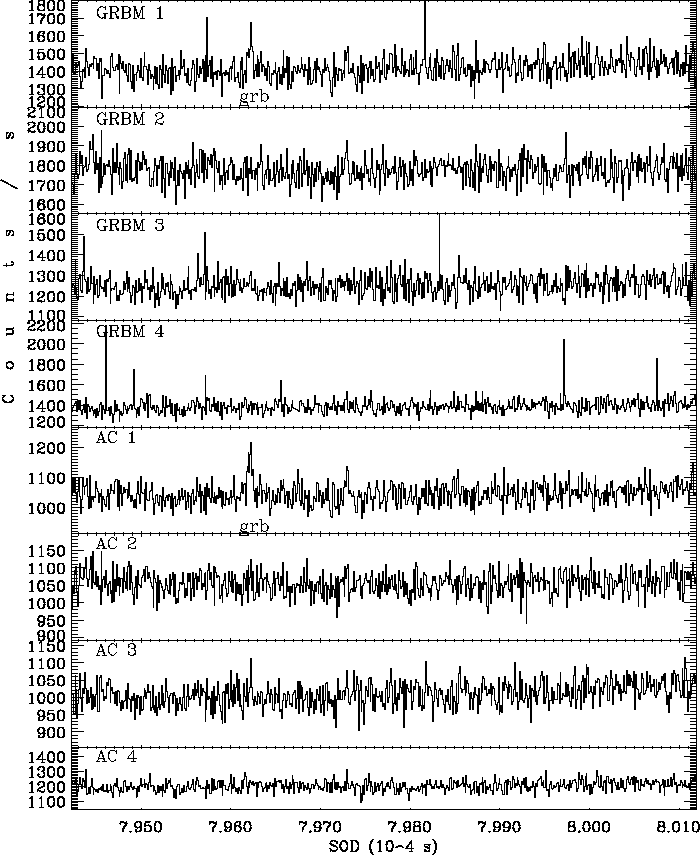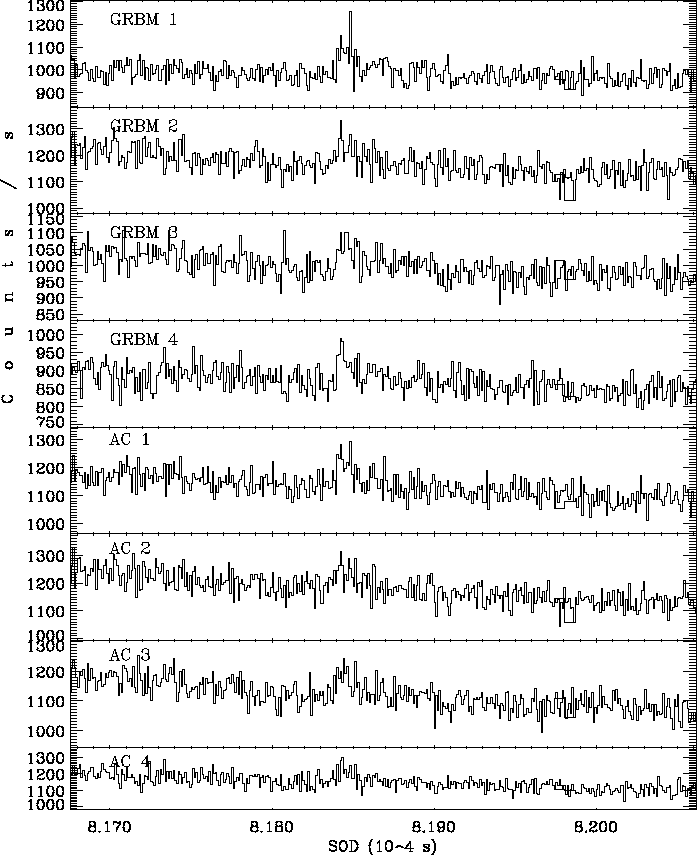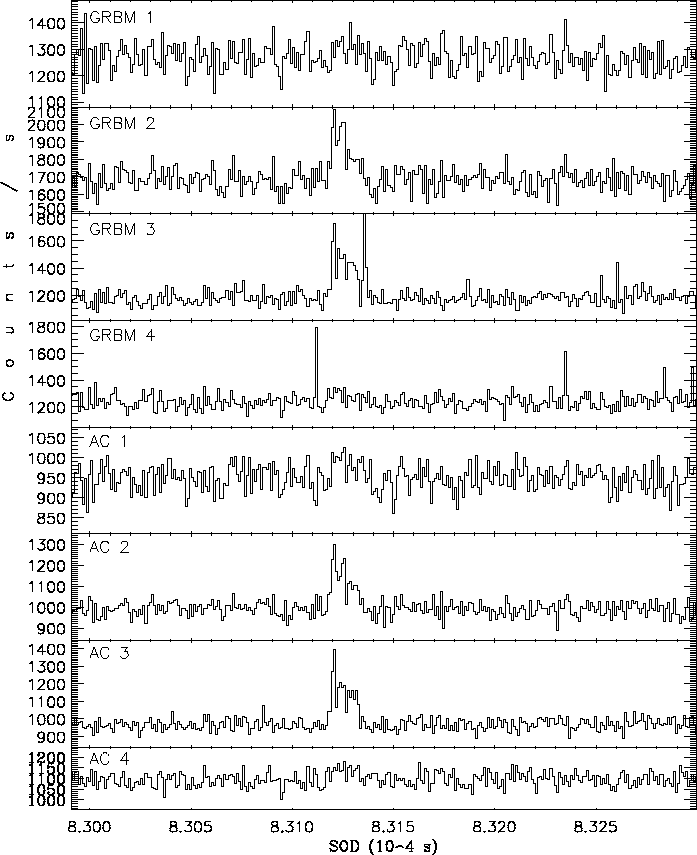



Next: Benefits and Drawbacks
Up: The Early SWTCs
Previous: Automatic Estimation of Total
Contents
In figg. ![[*]](crossref.png) ,
, ![[*]](crossref.png) ,
, ![[*]](crossref.png) ,
, ![[*]](crossref.png) ,
some time profiles of NTBs discovered by the different SWTCs are shown.
In tab.
,
some time profiles of NTBs discovered by the different SWTCs are shown.
In tab. ![[*]](crossref.png) the main characteristics of the same NTBs
are reported. All these events have been also detected
by BATSE (the corresponding trigger numbers are reported, as well).
In order to better understand why these bursts did not trigger the
GRBM on-board logic, the values of the on-board threshold
parameters
the main characteristics of the same NTBs
are reported. All these events have been also detected
by BATSE (the corresponding trigger numbers are reported, as well).
In order to better understand why these bursts did not trigger the
GRBM on-board logic, the values of the on-board threshold
parameters  expressed in
expressed in  are reported. For each
NTB the values of
are reported. For each
NTB the values of  in the two energy bands for the
triggered units are provided.
The detector unit number is also written within brackets.
in the two energy bands for the
triggered units are provided.
The detector unit number is also written within brackets.
In particular, NTB 960723 (fig. ![[*]](crossref.png) ),
whose BATSE direction is
),
whose BATSE direction is  11
11 off-axis with respect to unit 2, did not trigger the OBTCs,
because it had
off-axis with respect to unit 2, did not trigger the OBTCs,
because it had
 (on-board
threshold) and
(on-board
threshold) and
 ;
therefore, while it just triggered SWTC2, it matched no OBTC
in any unit.
The NTB 980421 (fig.
;
therefore, while it just triggered SWTC2, it matched no OBTC
in any unit.
The NTB 980421 (fig. ![[*]](crossref.png) ), just a little brighter
than the previous, did match the OBTC, but only in unit 1,
therefore, not enough to trigger the on-board logic;
however, it satisfied SWTC2 and SWTC3.
The case of NTB 960913 (fig.
), just a little brighter
than the previous, did match the OBTC, but only in unit 1,
therefore, not enough to trigger the on-board logic;
however, it satisfied SWTC2 and SWTC3.
The case of NTB 960913 (fig. ![[*]](crossref.png) ) is an example
of a burst, that did not trigger
on board, only because it happened during the dead time due to
a previous event (caused by a high-energy particle), that already
started the HTR mode: actually, the burst occurred just
3
) is an example
of a burst, that did not trigger
on board, only because it happened during the dead time due to
a previous event (caused by a high-energy particle), that already
started the HTR mode: actually, the burst occurred just
3 10
10
 after the previous event; since the minimum dead
time is
after the previous event; since the minimum dead
time is  7 min (tab.
7 min (tab. ![[*]](crossref.png) ), HTR counts could not
have been acquired; nevertheless, the on-board flag indicating the
occurrence of a new trigger was set to positive.
This bright NTB triggered all the SWTCs.
), HTR counts could not
have been acquired; nevertheless, the on-board flag indicating the
occurrence of a new trigger was set to positive.
This bright NTB triggered all the SWTCs.
Table:
Example of NTBs caught by the early SWTCs.
| GRB |
SW Trg |
BATSE |
GRBM Peak( ) ) |
AC Peak( ) ) |
On-board |
 |
 |
| |
UT |
trigger |
(SW thr  ) ) |
(SW thr  ) ) |
thr ( ) ) |
( ) ) |
( ) ) |
| 960723 |
04:46:06 |
5551 |
6 (2) |
3 (2) |
8 |
350 |
+4 |
| 960802 |
22:07:01 |
5559 |
7 (1) |
5 (1) |
8 |
283 |
+12 |
| 980421 |
22:44:02 |
6698 |
8 (1) |
4 (1) |
4 |
238 |
+47 |
| 960913 |
23:05:20 |
5604 |
9 (2) |
9 (2) |
8 |
23 |
-23 |
| |
|
|
12 (3) |
13 (3) |
8 |
|
|
Figure:
Time history of NTB 960802 (also BATSE trigger 5559) in all
the GRBM units, both energy bands. Only unit 1 detected it.
Like NTB 960723, also this NTB was caught trough SWTC 2:
its BATSE direction was  20
20 above the Earth limb and
above the Earth limb and
 18
18 off-axis with respect to unit 1.
off-axis with respect to unit 1.
 |
Figure:
Time history of NTB 980421 (also BATSE trigger 6698) in all
the GRBM units, both energy bands. The burst can be seen in
all the profiles, but it matched the OBTC only in unit 1, because
too faint in the other units. It triggered both SWTC 2 and SWTC 3.
Its BATSE direction was  73
73 above the Earth limb and
above the Earth limb and
 55
55 off-axis with respect to unit 1, the one with the best
SNR.
off-axis with respect to unit 1, the one with the best
SNR.
 |
Figure:
Time history of NTB 960913 (also BATSE trigger 5604) in all
the GRBM units, both energy bands. The burst was bright enough in
the units 2 and 3 to match the OBTCs, but, since it occurred during
the dead time of a previous fake event that triggered the GRBM, there
are no HTR counts of it. It triggered all the SWTCs.
Its BATSE direction was 
 and
and

 in the BeppoSAX frame of reference, i.e. bewteen the axes of units 2 and 3:
this fully agrees with the GRBM units that indeed detected it.
in the BeppoSAX frame of reference, i.e. bewteen the axes of units 2 and 3:
this fully agrees with the GRBM units that indeed detected it.
 |




Next: Benefits and Drawbacks
Up: The Early SWTCs
Previous: Automatic Estimation of Total
Contents
Cristiano Guidorzi
2003-07-31
![[*]](crossref.png) ),
whose BATSE direction is
),
whose BATSE direction is ![[*]](crossref.png) ), just a little brighter
than the previous, did match the OBTC, but only in unit 1,
therefore, not enough to trigger the on-board logic;
however, it satisfied SWTC2 and SWTC3.
The case of NTB 960913 (fig.
), just a little brighter
than the previous, did match the OBTC, but only in unit 1,
therefore, not enough to trigger the on-board logic;
however, it satisfied SWTC2 and SWTC3.
The case of NTB 960913 (fig. ![[*]](crossref.png) ) is an example
of a burst, that did not trigger
on board, only because it happened during the dead time due to
a previous event (caused by a high-energy particle), that already
started the HTR mode: actually, the burst occurred just
3
) is an example
of a burst, that did not trigger
on board, only because it happened during the dead time due to
a previous event (caused by a high-energy particle), that already
started the HTR mode: actually, the burst occurred just
3![[*]](crossref.png) ), HTR counts could not
have been acquired; nevertheless, the on-board flag indicating the
occurrence of a new trigger was set to positive.
This bright NTB triggered all the SWTCs.
), HTR counts could not
have been acquired; nevertheless, the on-board flag indicating the
occurrence of a new trigger was set to positive.
This bright NTB triggered all the SWTCs.


